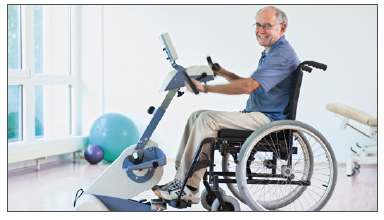Improving Speech and Swallowing Using sEMG and Breathing Therapy Biofeedback
ACP - Accelerated Care Plus
Recent Posts
SLP Clinical Connection - Celebrate Success
Topics: Dysphagia, Patient Success Story, Speech Rehab
Improving Functional Mobility and Cardiovascular Endurance with Electrical Stimulation and Exercise
Patient Information: Male, Age 73
Diagnosis: Chronic Obstructive Pulmonary Disease (COPD) exacerbation.
History: This gentleman was referred to a skilled nursing facility for rehabilitation services to address significant weakness and functional decline after an exacerbation of COPD.
Topics: Patient Success Story, Cardiopulmonary
Wound Healing Using Diathermy and Exercise
Patient Information: Female, Age 64
Diagnosis: Cellulitis / Venous Insufficiency Ulcer / DJD Bilateral Knees
History:
This woman was referred to a skilled nursing facility for rehabilitation services following hospitalization due to cellulitis of her left lower leg. Thirty years ago, she fell and injured her left ankle and developed a venous insufficiency ulcer, which has never fully healed and recently has gotten worse due to the cellulitis. Prior to her hospitalization, she required maximal (> 75%) assistance from her husband for activities of daily living (dressing and bathing) and transfers due to a prior stroke and bilateral knee degenerative joint disease causing knee pain, weakness, and limited range of motion.
Topics: Patient Success Story, Wound Management
Comprehensive Approach to Wound Healing
Wounds are typically managed with standard nursing care including maintaining a clean wound bed and appropriate dressings and medications. Therapeutic interventions including biophysical agents can be used to directly facilitate and accelerate wound healing. Factors such as pressure, pain, and contracture may delay wound progression or cause wounds to reoccur. Addressing these adjunctive factors related to the wound provides the best overall approach to wound management and limits the risk of reoccurrence.
Topics: Clinical Tip, Wound Management
Improving Swallow Ability with sEMG and Exercise
Patient Information: Female, Age 75
Diagnosis: Supraglottic Cancer / Oropharyngeal Dysphagia / Chronic Obstructive Pulmonary Disease
History: This woman was referred to a skilled nursing facility for rehabilitation services due to progressively worsening swallow function following completion of radiation therapy for supraglottic (throat) cancer. During hospitalization, a video fluoroscopic swallow study (VFSS) was conducted due to dysphagia (difficulty swallowing) indicating aspiration (material entering the lungs), and a feeding tube was placed for all nutritional needs. Prior to the onset of throat cancer, she ate a regular diet.
Topics: Dysphagia, Patient Success Story
Ventilatory Strategies for Cardiopulmonary Conditions
Individuals with cardiopulmonary conditions often present with dyspnea, severe weakness, poor endurance, limited mobility, and decreased activity tolerance. As their disease state progresses, their ability to perform activities of daily living (ADLs) declines, ultimately leading to a loss of independence. A therapy plan of care that includes breathing exercises, energy conservation techniques (e.g., paced activity, assistive device, task planning), and ventilatory strategies may improve the individual’s breathing and functional performance as well as help maintain independence.
Topics: Clinical Tip, Cardiopulmonary
Decreasing Pain and Improving Strength Using Diathermy and Exercise
Patient Information: Female, Age 78
Topics: Pain Management, Patient Success Story
Dementia Care With Advanced Rehabilitation Technology: Exercise
According to the CDC, dementia affects one’s ability to remember, think, and make decisions that impact daily activities and safety. Alzheimer’s disease (AD) is the most common type of dementia accounting for 60-80% of cases. As dementia progresses to increased levels of memory loss and confusion, the individual becomes more sedentary and frail. Rehabilitation in this population should be tailored to patient needs addressing cognition, strength, gait, balance, endurance, and function.
Topics: Clinical Tip, Neuro Rehab
Improving Activity Tolerance and Functional Mobility Using Breathing Therapy and Exercise
Patient Information: Female, Age 64
Diagnosis: Acute Respiratory Failure / COVID-19 / Chronic Obstructive Pulmonary Disease (COPD)
History:
This woman was referred to a skilled nursing facility due to severe debility following a seven week hospitalization due to COVID-19. Her condition was complicated by diabetes, COPD, and pulmonary fibrosis. At the time of hospital discharge, she required 8 liters per minute of supplemental oxygen to maintain oxygen saturation level. Prior to hospitalization she lived with her family in a 2-story home, was independent with walking and all self-care, and worked as a construction supervisor.
Topics: Patient Success Story, Cardiopulmonary
Interventions for Individuals with Parkinson's Disease
Parkinson’s disease (PD) is a progressive neurodegenerative disorder often requiring therapy to address motor symptoms such as bradykinesia, rigidity, tremors, shuffling and freezing gait, poor postural control, and impaired balance. Exercise plays a key role in rehabilitation for this population with additional benefits being achieved by incorporating biophysical agents and advanced technologies. Research demonstrates that exercise improves motor skill performance, which may be enhanced with cognitive engagement through feedback, cueing, dual-tasking training, and motivation (Petzinger, et al., 2013).
Topics: Clinical Tip, Neuro Rehab





